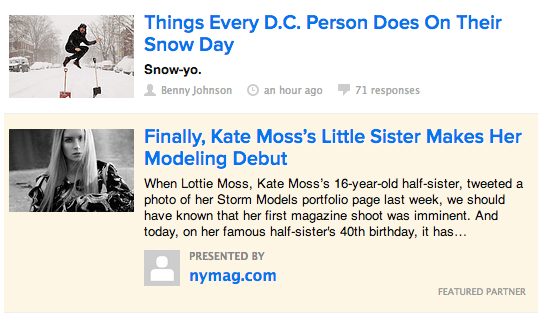With the New York Times adding native advertising to its redesigned website this year, there is no doubt that we will continue to see more online publishers and social networks use branded content. Some use it well, and some not so well. We looked at the New York Times, Buzzfeed, and Pinterest to explore the benefits and drawbacks of native advertising for each.
New York Times
Dell is the first to use NYTimes’ native advertising program, attempting to add relevant content to the website. The content is actually quite good, though it could easily be missed under the bright blue ‘Paid Post’ label.
 (via NYTimes)
(via NYTimes)
The good thing is that readers can’t really mistake Dell’s content for actual New York Times content, thus eliminating any complaints regarding deception. Transparency is useful for Dell here. On the other hand, the content looks so different and is highlighted so much that it can look like a typical banner ad, thus repelling certain readers from even clicking.
Buzzfeed
Buzzfeed has run native advertising for a while now, and they make a killing with it. The online publisher is expecting $120 million in revenue this year, after predicting $60 million in revenue last year, due to their advertising deals.
Native ads are a bit more streamlined on Buzzfeed’s website, where they can blend into regular content, but are still noticeably sponsored.
 (via Buzzfeed)
(via Buzzfeed)
Brands know that they have to vibe with the same audience who is reading Buzzfeed, so they come up with very similar content. The issue comes when there’s so much content on Buzzfeed’s website, that cute animals and gifs of people falling have completely saturated all content. It’s very hard for a regular article to go viral, but especially hard for a brand.
Pinterest promoted pins are still in the testing phase, we should expect to see them this year. They are seemingly…the most seamless ads, looking exactly like regular pins with an extra line below calling out the promoted pin.
Promoted pins could prove very useful, as members of the site search for useful items and ideas, and of course, brands want those people to find their products. If the promoted pins are targeted correctly, they could be very useful for members and advertisers alike.
Which form of native advertising do you like best? Of course, you should only choose a channel based on your audience, but the form in which your content will show up should also be a concern. If you’re looking for more information on other native advertising, we also have more about Yahoo’s new marketing efforts.

